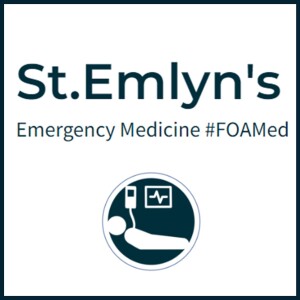
Welcome to the St. Emlins blog. I’m Iain Beardsell, and I’m joined by our resident pediatric expert, Natalie May. Today, we’re discussing a challenging but crucial topic for those in Emergency Medicine: managing pediatric patients with shortness of breath.
Understanding Pediatric Shortness of Breath
Shortness of breath in children is a frequent and often intimidating presentation in the emergency department, especially during winter. This guide aims to provide a systematic approach to assess and manage these young patients effectively.
Initial Assessment: Stay Calm and StructuredWhen managing a child with shortness of breath, it's essential to stay calm and use a structured approach:
- Level of Consciousness: Determine if the child is alert or needs immediate resuscitation.
- Breathing Effort: Look for signs of respiratory distress such as the use of accessory muscles, intercostal and subcostal recession, tracheal tug, or head bobbing in infants.
- Breathing Efficacy: Listen for extra sounds like wheezes or stridor to identify the underlying pathology.
- Oxygen Delivery: Check the child's oxygen saturation, level of consciousness, and heart rate to evaluate breathing effectiveness.
Administering oxygen is a safe and effective initial treatment for children with shortness of breath. It is unlikely to cause harm and can be crucial for stabilizing the patient while further assessments are made.
Detailed History and Physical ExaminationGathering a detailed history from the parents is essential:
- Chronology of Events: Determine how long the child has been short of breath.
- Pre-existing Conditions: Ask about any previous lung problems.
- Additional Symptoms: Note any associated symptoms like fever or cough.
- Inhaled Foreign Body: Consider this, especially if the onset of symptoms was sudden.
This information helps in deciding the appropriate therapy and whether the child needs hospital admission.
Common Causes of Pediatric Shortness of Breath 1. Bronchiolitis and Viral WheezeBronchiolitis is a common winter illness in children under two, often caused by respiratory syncytial virus (RSV). Key signs include:
- Respiratory distress with significant use of accessory muscles.
- Wheezing and low oxygen saturation.
- History of recent cold symptoms in the family.
Viral Wheeze often presents similarly but occurs in slightly older children. Differentiating between bronchiolitis and viral wheeze involves assessing the severity and duration of symptoms.
Management:
- Oxygen: Provide supplemental oxygen if saturation levels are low.
- Bronchodilators: Trial with salbutamol through a spacer or nebulizer can be beneficial.
- Steroids: Generally avoided in children under five unless there is a formal asthma diagnosis or previous steroid-responsive episodes.
Admission Criteria:
- Severe respiratory distress.
- Persistent low oxygen saturation.
- Poor feeding and hydration status.
- History of prematurity or chronic lung disease.
Croup is another common viral illness presenting with a characteristic seal-like barky cough and inspiratory stridor. It often worsens at night, causing significant distress to both the child and the parents.
Management:
- Dexamethasone: A single oral dose (0.15-0.6 mg/kg) is effective in reducing airway inflammation and improving symptoms.
- Observation: Monitor the child for 2 hours post-treatment to ensure improvement.
- Calm Environment: Minimize distress and avoid unnecessary interventions that might exacerbate symptoms.
Safety Netting:
- Provide parents with clear instructions on when to return to the hospital, especially if symptoms worsen during the night.
Though less common than viral infections, bacterial pneumonia should be considered, particularly if the child presents with:
- Fever.
- Persistent cough.
- Decreased oxygen saturation.
- Subtle respiratory distress.
Management:
- Chest X-ray: Useful for diagnosis if bacterial infection is suspected.
- Antibiotics: Initiated based on clinical judgment and X-ray findings.
- Admission: Necessary for children with significant respiratory compromise or those unable to maintain adequate oxygen levels.
Children with respiratory distress often have poor oral intake, leading to dehydration. Assess feeding history and urine output:
- Supportive Feeding: Nasogastric or intravenous fluids may be required.
- Monitor Hydration: Ensure adequate fluid intake and monitor for signs of dehydration.
Infants are obligate nasal breathers, and nasal congestion can severely impact their breathing. Simple measures such as nasal saline drops can alleviate congestion and improve breathing.
Inhaled Foreign BodiesAlways consider the possibility of an inhaled foreign body, especially if the presentation is sudden and there is no clear viral cause. A chest X-ray or bronchoscopy may be required for diagnosis and management.
Conclusion: A Structured Approach for SuccessManaging pediatric shortness of breath requires a calm, structured approach, leveraging skills from adult practice and adapting them for pediatric patients. Key steps include:
- Initial Assessment: Stay calm and systematic.
- Oxygen Administration: A safe first step.
- Detailed History and Physical Examination: Crucial for diagnosis.
- Management of Common Conditions: Bronchiolitis, viral wheeze, croup, and bacterial pneumonia.
Remember, there is always senior support available, whether from a senior emergency physician or a pediatric colleague. By staying cool and methodical, you can effectively manage these challenging cases and provide excellent care for your young patients.
Stay tuned to the St. Emlins blog for more in-depth discussions on pediatric emergencies and other critical topics in emergency medicine. Stay calm, stay curious, and keep learning.
More Episodes
 2024-04-17
2024-04-17
 2.0k
2.0k
 2023-11-09
2023-11-09
 3.3k
3.3k
 2023-09-18
2023-09-18
 3.2k
3.2k
Create your
podcast in
minutes
- Full-featured podcast site
- Unlimited storage and bandwidth
- Comprehensive podcast stats
- Distribute to Apple Podcasts, Spotify, and more
- Make money with your podcast
It is Free
- Privacy Policy
- Cookie Policy
- Terms of Use
- Consent Preferences
- Copyright © 2015-2024 Podbean.com




